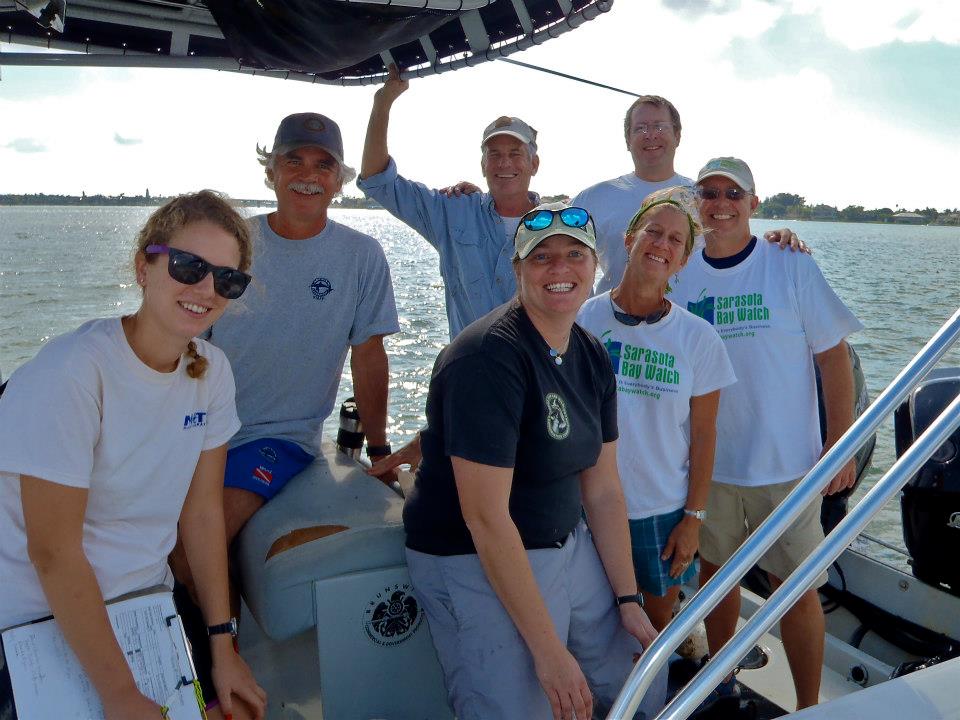Clam Restoration Project in Sarasota Bay

In 2016 Sarasota Bay Watch started a new shellfish restoration initiative focused on the southern hardshell clam. The southern hardshell clam (Merceneria campechiensis) was once abundant in Sarasota Bay. Now populations have dwindled to just a few locations. These bivalves are crucial to Sarasota Bay’s ecosystem and water quality. A single littleneck-sized clam can filter 4.5 gallons of water per day.
In 2016 Sarasota Bay Watch invested in brood stock for 250,000 southern hardshell clams and partnered with Two Docks Shellfish and Bay Shellfish company to grow these filter feeders to over 2 inches in size. At this size there are few predators that will disturb them once released.
In 2018 Sarasota Bay Watch volunteers performed several releases along Sarasota Bay of these clams to encourage population growth of the native southern hardshell clams. These clams were able to survive the large red tide event in the summer of 2018 and our scientific partners at Mote Marine Laboratories report that they have continued to thrive despite extended periods of red tide.
In 2019 Sarasota Bay Watch made a further investment for the future of clam restoration by investing in an additional 750,000 clams for the coming years.
In 2020 Sarasota Bay Watch increased its investment in clam restoration to one million (1,000,000) clams thanks to a grant from the Marjory and Charles Barancik Foundation.” Deployment will begin when the Covid-19 threat has passed.
Longterm Scallop Restoration Project in Sarasota Bay

Sarasota Bay Watch’s Scallop Restoration is a multifaceted collaborative effort which is financially independent of Federal, State and Local funding. This community-driven approach provides long-term continuity by avoiding the pitfalls of intermittent grants. Furthermore, the project is scalable. When additional restoration funds are available SBW can increase the number and scope of scallop releases to further enhance the chances of restoration success. We believe that this is a model other communities can use to design their own restoration projects.
The community is involved in fundraising, and participating in scallop searches, pre-release dive assessments of release locations, scallop releases and follow-up data collection. High school students have been involved in the construction of scallop spat collectors to support scientific monitoring. Businesses provide sponsorship of annual releases and donations of money as well as goods/services for auction at fundraisers. SBW works hand in glove with Mote Marine Laboratory, Sarasota Bay Estuary Program and Florida Fish and Wildlife Research Institute to plan and implement scallop releases and data collection.
History
- Since 2008 SBW has sponsored its annual Great Sarasota Bay Scallop Search, engaging over 500 people who volunteered their time and boats to snorkel Sarasota Bay sea grass beds and count scallops. These annual scallop searches created community awareness about the lack of scallops in the bay.
- Bginning in 2011 SBW created a community-based partnership of engaged citizens, organizations and local businesses, along with regional scientific and research groups, to undertake a long-term project to restore scallops to Sarasota Bay.
- The restoration project is community-led, locally providing the majority of the funding and volunteers, while research partners study the science of the restoration process. Community awareness and engagement levels have increased dramatically.
- In 2011 SBW launched its yearly fundraiser “Scallopalooza” to rasie money for scallop restoration in Sarasota Bay. To date SBW has raised $37,000.
- These funds allowed SBW to release over 24 million scallop larvae, in a half dozen releases, from December 2011 to January 2013 in conjunction with Mote Marine Laboratories, Sarasota Bay Estuary Program and Florida Fish and Wildlife Research Institute including free releases, boom-contained releases, and a combination of boom and free releases.
Citizen Science
- SBW’s citizen-scientist core was a catalyst that connected our community with our research organizations. SBW was able to build a bridge connecting the community’s environmental stewardship, volunteerism and charity, with scientific rigor and data collection by the research entities.
- The result is that this partnership of community and research provides continuity and scale not otherwise seen anywhere else, at any time, in Florida. Continuity and scale are critical to sustaining a long-term scallop restoration project.
- The timing and location of releases are informed by scientific advice about water quality, sea grass quality, red tide threats, down-stream poaching potential, etc.
An additional consideration is diversification of release locations and conditions in order to increase restoration success chances, since so many variables are still unknown about the scallop restoration process.

Measure Success
- Growing database of release locations, timing, conditions, water parameters, etc. will be useful to help quantify and improve the scallop restoration process.
- Restoration success can be measured on three axes: Community awareness and engagement, improved scientific research around the scallop restoration process, and scallop repopulation.
Educational Outreach
- SBW sponsors various “on-the-water” activities throughout the year for volunteers as well as participates in local events to educate the community on scallop restoration including: the Youth Ocean Conservation Summit, Earth Day, Eco-Fest, Sarasota’s Watershed Conference and World Oceans Day.
- High school students have been engaged to construct the larval and juvenile scallop collectors used at scallop release sites to collect data.
- SBW sponsored a student-created field guide to local marine life, and donated copies to schools and youth groups to help “bring the bay into the classroom.”



